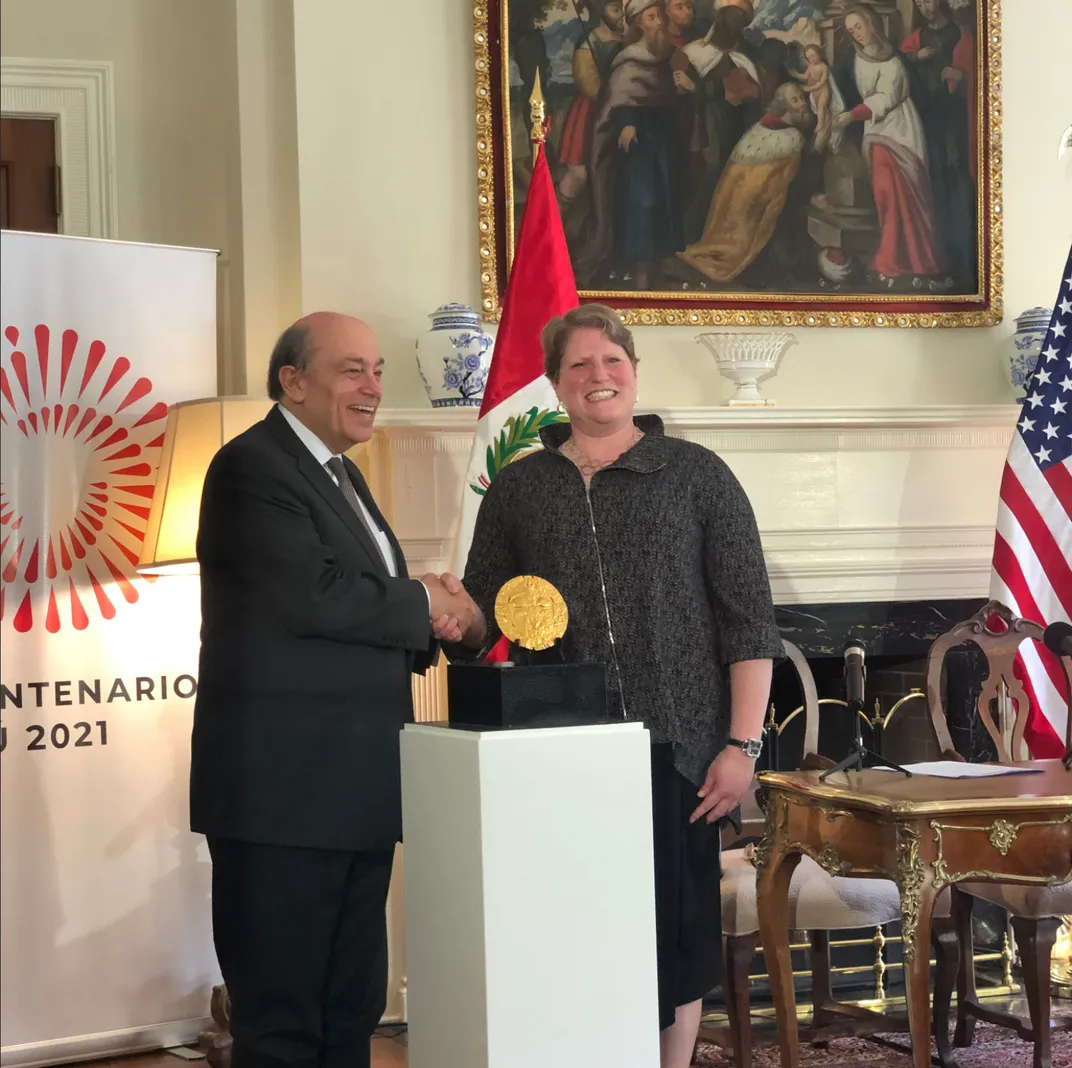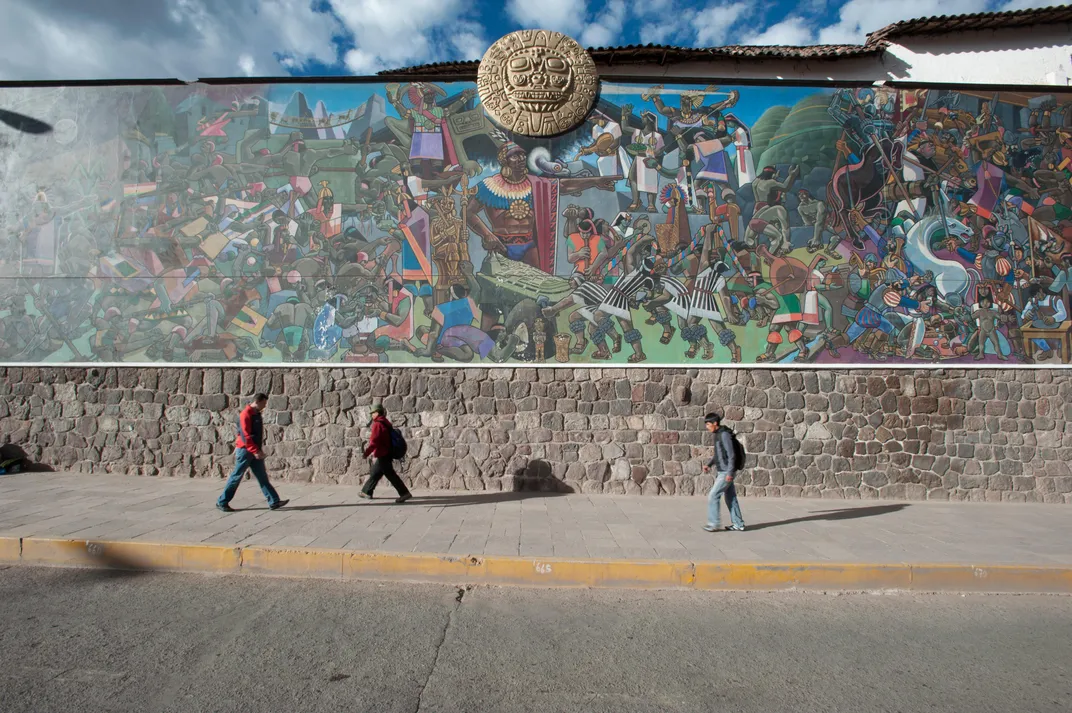A Golden Symbol of National Identity Returns to Peru
The Smithsonian’s National Museum of the American Indian has sent an ancient, pre-Inca breastplate back home
:focal(396x300:397x301)/https://tf-cmsv2-smithsonianmag-media.s3.amazonaws.com/filer/79/4e/794e735c-3d5b-4052-8d58-ed69ada50e84/take_2.png)
Walk down the historic streets of Cusco, Peru, and the same symbol pops up all over: a round, golden face surrounded by an intricate ring of interlocking embossed patterns. Replicas big and small glitter from gift shop windows and adorn everything from street signs to public art, fountains and government buildings.
“It’s really everywhere,” recalls Amy Van Allen, a Smithsonian Institution project manager who visited the city with a group of scholars in fall 2019. “You can’t miss it.”
The icon derives its design from a one-of-a-kind national treasure: the Sol de Soles (Sun of Suns), also known as the Sol de Echenique (after its one-time steward, Peruvian President José Rufino Echenique) or simply the Placa de Echenique (Echenique Disc). Ancient Andean artisans crafted the object by carefully hammering and heating a thin, shimmery gold alloy disc measuring just 5.3 inches in diameter. Thousands of years later, in 1986, the city of Cusco adopted the symbol as its official seal.
Despite its cultural significance to the Inca imperial city, the artifact itself has remained conspicuously absent from Cusco. For more than a century, the Echenique Disc resided far from home, in the Washington, D.C. collections of the Smithsonian’s National Museum of the American Indian (NMAI).
That changed last week, when the Smithsonian formally returned the historic golden plaque to its country of origin. In a June 15 ceremony at the Peruvian ambassador’s D.C. residence, representatives from the Smithsonian, Peru’s ministries of culture and foreign affairs, and the municipality of Cusco signed a memorandum of understanding returning the disc on behalf of the country’s citizens and Indigenous communities.
According to the museum, scholars—foremost among them the Peruvian archaeologist Jorge A. Calero Flores—generally agree that the disc dates to one of Peru’s Early Horizon Period cultures (circa 800 B.C. to 1 A.D.). Contrary to assumptions made based on Cusco’s rich, well-documented history as the capital of the Inca Empire, the object actually predates the famed civilization, which arose in the 12th or 13th century and collapsed in the aftermath of the Spanish Conquest.
“This return is consistent with the museum’s mission to facilitate the continuity and renewal of Indigenous cultural traditions,” says the museum’s acting director, Machel Monenerkit, in a statement. “I am proud to mark this moment together.”
Per the museum, the disc will now be incorporated into Peru’s national inventory of cultural heritage. It will eventually go on public display, though officials have yet to determine exactly where—likely somewhere in Cusco, as Peruvian culture minister Alejandro Neyra tells Lima-based newspaper El Comercio.
Peruvian officials have advocated for the disc’s recovery since at least 2017, when the municipality of Cusco sent a formal letter requesting its return to the Smithsonian.
“We were exploring options for a long-term loan” at the time, says Van Allen, who works at NMAI and participated in discussions about the disc’s return. After a series of negotiations, the Institution decided to deaccession and return the disc permanently—no strings attached.

Though not technically classified as such, the choice fit with the museum’s mission of empowering Indigenous communities through processes such as repatriation.
“This was a really special opportunity to return an item that has been so important to this country,” especially its Indigenous communities, Van Allen says.
The disc’s return differs from official acts of repatriation, which in the Smithsonian’s case are governed by the 1989 National Museum of the American Indian Act. Although the artifact is being returned on behalf of representatives from Peru’s Indigenous communities, it will be stewarded by the government, rather than being restored directly to lineal descendants of these communities.
The distinction stems partly from the disc’s age, as well as a lack of definitive scholarship on the item. Slits on either side of the small plate suggest it was worn as a breastplate or chest ornament, but beyond that, says Van Allen, archaeologists have not reached a consensus on what its iconography symbolizes.
According to research compiled by the museum, the wafer-thin object (measuring just 0.016 inches thick) was crafted from an alloy composed of 90 percent gold, 5 percent silver and 5 percent copper and shaped via metalworking techniques common among many ancient Andean cultures at the time. Archaeologist John H. Rowe asserted in 1976 that the face is meant to depict a sun god or rayed deity, but others, including Flores, have argued that the rounded eyes and nose represent a feline icon.
Though its origins are still subject to debate, the disc’s modern history is far easier to trace. In 1853, British geographer Clements R. Markham traveled to Peru, where he attended a high society dinner with Echenique, then-president of the newly independent country. When the leader brought the shining disc out to display to his guests, Markham was so impressed that he made a careful copy of the item with tracing paper.
Detailing the trove of treasures presented by Echenique in his 1910 travel memoir, Markham in Peru, the scholar wrote, “They are by far the most important Inca relics I have ever seen, either in museums or elsewhere.”
/https://tf-cmsv2-smithsonianmag-media.s3.amazonaws.com/filer/4f/e5/4fe54224-05df-4cdd-ab0d-122e2f290a53/screen_shot_2021-06-23_at_84049_am.png)
Other European observers, including British collector William Bollaert, wrote about the brilliant gold ornament in Echenique’s possession during the mid-1800s. But the golden item vanished from the historical record until the early 1900s, when one of the former president’s descendants seemingly sold the precious object to German physician and collector Eduard Gaffron.
George Gustav Heye, an American industrialist who made a fortune off of family ties to the Standard Oil Company and his own investment banking firm, purchased the disc in 1912, according to the museum’s American Indian magazine. An obsessive collector, Heye amassed the largest trove of Indigenous cultural heritage objects ever acquired by one person.
When Heye’s foundation and the New York City–based Museum of the American Indian fell on hard times in the late 20th century, they merged with the Smithsonian to create NMAI. At the Smithsonian, the small golden disc featured in multiple exhibitions, including “Star Gods of the Ancient Americas” (1982–1984), “Our Peoples: Giving Voice to Our Histories” (2004–2014) and “The Great Inka Road: Engineering an Empire” (2015–2021).
In Cusco, meanwhile, a charismatic leader rediscovered the Echenique Disc and designated it the city’s new emblem. As mayor from 1984 to 1986, and again from 1990 to 1995, Daniel Estrada Pérez undertook an ambitious effort to reinvigorate a distinctive Cusco culture that celebrated its rich history as the center of the Inca Empire, wrote anthropologist Helaine Silverman for Heritage Management journal in 2008. These initiatives included massive public sculptures rendered with specifically Indigenous iconography, as well as the installation of new museums and theaters.
During this citywide redesign, the municipality also rejected the city’s old seal, which dated to the Spanish colonial period and, for many, symbolized a lingering reminder of the damage wrought by European conquest, in favor of the sun disc.
/https://tf-cmsv2-smithsonianmag-media.s3.amazonaws.com/filer/e8/9e/e89e4b5b-00ae-440e-8311-82dd36eedea0/gettyimages-800630380.jpg)
Estrada’s efforts laid the groundwork for subsequent mayors of Cusco to push for the disc’s unconditional return. Last week, these campaigns finally achieved their goal: On June 17, gloved conservators carefully inspected the gold item, newly arrived back in its home country. The following day, its return was officially celebrated at a ceremony attended by Peruvian President Francisco Sagasti.
This event was just the beginning of the disc’s planned outings, reports El Comercio. Its return happens to coincide with the bicentennial of Peru’s independence from Spain, which is set to be celebrated throughout the month of July.
The disc’s return also lines up with Inti Raymi, a major festival in Cusco celebrated on the winter solstice. Some observers expect the long-awaited golden disc to make an appearance at the festivities. Although gatherings will be curtailed this year due to the Covid-19 pandemic, a crew of actors decked in colorful traditional attire is set to parade and perform in honor of the Inca sun god Inti.
Like previous years, the cast will include a central actor who wears a breastplate modeled after—what else?—the Echenique disc.
As culture minister Neyra tells El Comercio, the fortuitous timing of the disc’s return makes for an exciting moment in Peruvian history.
“Because it is such a representative piece,” he says, “this must be, at least symbolically, the most important recovery that the Peruvian State has made in a long time.”
/https://tf-cmsv2-smithsonianmag-media.s3.amazonaws.com/accounts/headshot/nora.png)

/https://tf-cmsv2-smithsonianmag-media.s3.amazonaws.com/filer/91/fc/91fc4745-a9f5-4fd0-b3cb-64f1ea7baeda/cuzco_peru_15085741002.jpeg)
/https://tf-cmsv2-smithsonianmag-media.s3.amazonaws.com/accounts/headshot/nora.png)